 |
Home | Charity | Feedback |
India: Karnataka:
Bijapur,
Coorg,
Hampi,
Kudalasangama,
Mysore,
Nagarhole with Irpu Falls
Hampi, Karnataka, India: Cast in stone by Prakash Bang, Editor in Chief 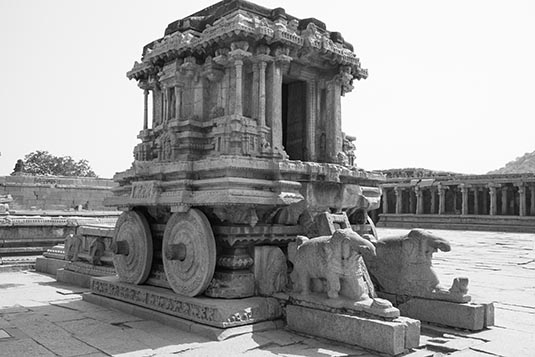 Locally, the name Hampi also means "champion". It is located within the ruins of the city of Vijayanagara, the former capital of the Vijayanagara Empire. Predating the city of Vijayanagara, it continues to be an important religious centre, housing the Virupaksha Temple, as well as several other monuments belonging to the old city. Traditionally known as Pampa-kshetra, Kishkinda-kshetra or Bhaskara-kshetra the current name is derived from Pampa, which is the old name of the Tungabhadra River on whose southern banks Hampi is built. 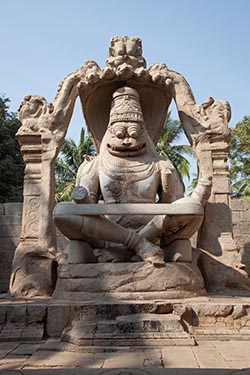 Along with my family, I decided to spend a weekend at Hampi. January was a good month, though I missed the Hampi Festival by a few days. The winter months are a blessing in the region. Because of granite all around, the summers become unbearably hot, making it very difficult to enjoy the sculptures around that are all out in the open.
Along with my family, I decided to spend a weekend at Hampi. January was a good month, though I missed the Hampi Festival by a few days. The winter months are a blessing in the region. Because of granite all around, the summers become unbearably hot, making it very difficult to enjoy the sculptures around that are all out in the open.
Hampi is about 600 kms from Pune, my hometown. My in-laws hail from Solapur that is about 250 kms from Pune – making it a perfect place to break the journey. We left Solapur post breakfast at about 8AM. Bypassing the historic town of Bijapur (you can read about it in one of my earlier blogs) we reached the town of Hampi in the evening. For our 2-night stay we had booked at Hyatt Place, a property in the campus of Jindal Steel about 30 kms from downtown. Sure, there were a few options in town but I preferred Hyatt for the comfort it offered. Moreover, the Jindal campus in itself was a reward. In any case, the ruins of Hampi are scattered in a 26 sq.km. area, so the distance did not really matter, especially if you have a car on hand. 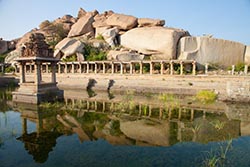 It is highly recommended to avail the services of a local guide to show you around. Without a learned person by your side, the fun would be lost, especially if you are short with time. I just had a day with me. Some research on the internet pointed that I avail the services of Parshuram – the approved tourist guide. The charge for the day was fixed for Rs 2000, which was certainly worth it.
It is highly recommended to avail the services of a local guide to show you around. Without a learned person by your side, the fun would be lost, especially if you are short with time. I just had a day with me. Some research on the internet pointed that I avail the services of Parshuram – the approved tourist guide. The charge for the day was fixed for Rs 2000, which was certainly worth it.
At 9AM the next morning we met Parshuram at the gates of Sasivekalu Ganesha Temple – a 30-minute drive from our hotel. From there began our exploration. 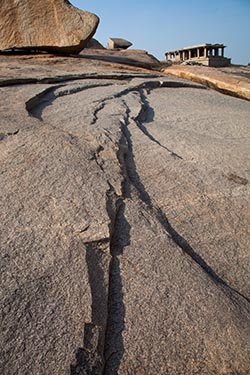 Immediately before the rise of the Vijayanagara kings, the region was probably in the hands of chiefs of Kampili, now a small town, 19 km east of Hampi. Hampi formed one of the core areas of the capital of the Vijayanagara Empire from 1343 to 1565, when it was finally laid siege to by the Deccan Muslim confederacy. Hampi was chosen because of its strategic location, bounded by the torrential Tungabhadra River on one side and surrounded by defensible hills on the other three sides. The site is significant historically and architecturally. The topography abounds with large stones which have been used to make statues of Hindu deities.
Immediately before the rise of the Vijayanagara kings, the region was probably in the hands of chiefs of Kampili, now a small town, 19 km east of Hampi. Hampi formed one of the core areas of the capital of the Vijayanagara Empire from 1343 to 1565, when it was finally laid siege to by the Deccan Muslim confederacy. Hampi was chosen because of its strategic location, bounded by the torrential Tungabhadra River on one side and surrounded by defensible hills on the other three sides. The site is significant historically and architecturally. The topography abounds with large stones which have been used to make statues of Hindu deities.
The city of Vijayanagara was originally encompassed by seven lines of fortifications. These fortifications had a large number of bastions & gateways. The seventh & the innermost fortification enclosed the main city & is the best preserved. The extant monuments of Vijayanagara or Hampi can be divided into Religious, Civil & Military buildings. While most of the monuments at Hampi are from the Vijayanagara period, a small proportion may be assigned to pre-Vijayanagara times. The Jain temples on Hemakuta hill, the two Devi shrines & some other structures in the Virupaksha temple complex predate the Vijayanagara Empire. The earliest amongst them, the Shaiva shrines with their stepped pyramidal vimanas or superstructures, date to the early Chalukyan period around 9th / 10th century. 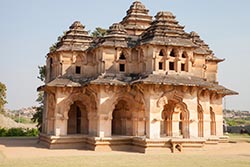 On the foothills of Hemkuta Hills, standing 8 feet tall, the statue of Sasivekalu Ganesha dates back to the 16th century. According to an inscription found near the statue, the pavilion that houses the statue was built in 1506 AD. It was constructed by a merchant from Chandragiri (a place in present day Andhra Pradesh) in memory of the then king of Vijayanagara, Narasimha II (1491–1505 AD). The statue is in a sitting position (half-lotus posture) and has four arms. The upper right hand of the statue has a goad while the lower right hand holds the broken tusk. The upper left hand of the statue holds a noose. The lower left hand of the statue has a sweet. There is a large open mantapa or pavilion surrounding the statue. The mantapa has rough plain pillars on it. Sasivekalu is mustard in the local language. The name refers to the shape of Ganesha belly's which quite resembles a mustard seed.
On the foothills of Hemkuta Hills, standing 8 feet tall, the statue of Sasivekalu Ganesha dates back to the 16th century. According to an inscription found near the statue, the pavilion that houses the statue was built in 1506 AD. It was constructed by a merchant from Chandragiri (a place in present day Andhra Pradesh) in memory of the then king of Vijayanagara, Narasimha II (1491–1505 AD). The statue is in a sitting position (half-lotus posture) and has four arms. The upper right hand of the statue has a goad while the lower right hand holds the broken tusk. The upper left hand of the statue holds a noose. The lower left hand of the statue has a sweet. There is a large open mantapa or pavilion surrounding the statue. The mantapa has rough plain pillars on it. Sasivekalu is mustard in the local language. The name refers to the shape of Ganesha belly's which quite resembles a mustard seed.
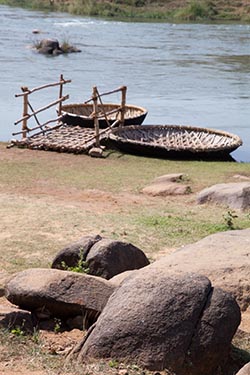 It’s a good idea to reach the Virupaksha Mandir by climbing up and then down on the Hemkuta Hills. The view and the various rock formations are truly awe-inspiring. The hills have a cluster of temples and a pond that goes back centuries.
It’s a good idea to reach the Virupaksha Mandir by climbing up and then down on the Hemkuta Hills. The view and the various rock formations are truly awe-inspiring. The hills have a cluster of temples and a pond that goes back centuries.
Virupaksha Temple is the main center of pilgrimage at Hampi and has been considered the most sacred sanctuary over the centuries. It is fully intact among the surrounding ruins and is still used in worship. The temple is dedicated to Lord Shiva, known here as Virupaksha, as the consort of the local goddess Pampa who is associated with the Tungabhadra River. The temple's history is uninterrupted from about the 7th century. The Virupaksha-Pampa sanctuary existed well before the Vijayanagara capital was located here. Inscriptions referring to Shiva date back to the 9th and 10th centuries. What started as a small shrine grew into a large complex under the Vijayanagara rulers. Evidence indicates there were additions made to the temple in the late Chalukyan and Hoysala periods, though most of the temple buildings are attributed to the Vijayanagar period. 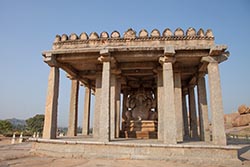 Under the Vijayanagara rulers, in the middle of the 14th century, there began a flowering of native art and culture. When the rulers were defeated by Muslim invaders in the 16th century, most of the wonderful decorative structures and creations were systematically destroyed.
Under the Vijayanagara rulers, in the middle of the 14th century, there began a flowering of native art and culture. When the rulers were defeated by Muslim invaders in the 16th century, most of the wonderful decorative structures and creations were systematically destroyed.
The cult of Virupaksha-Pampa did not end with the destruction of the city in 1565. Worship there has persisted throughout the years. At the beginning of the 19th century there were major renovations and additions, which included ceiling paintings and the towers of the north and east gopurams. 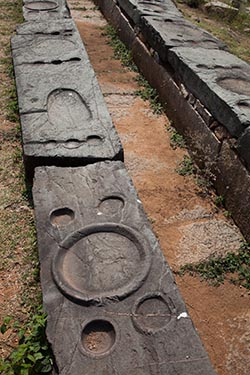 We next moved towards Lakshmi-Narasimha, popularly called Ugranarasimha, meaning Narasimha (lion headed God) of terrifying countenance. It is hewn out of a solid rock. According to an inscription found here, it was executed in 1528 AD during the rule of Krishnadevaraya. Originally, the icon bore a smaller image of Lakshmi sitting on his lap. This gigantic image, 6.7 meters in height, was mutilated and the figure of Lakshmi was entirely damaged and vandalized in 1565 AD. Narasimha with an articulately chiseled and well delineated mane and large bulging eyes and broad chest still retains his awesome charm. He is seated on the coils of the snake Adisesha, who rises behind him with seven hoods, which serve as a canopy. The entire image is set within a Makara torana, or arch, with a lion-mask above the hoods of Adisesha.
We next moved towards Lakshmi-Narasimha, popularly called Ugranarasimha, meaning Narasimha (lion headed God) of terrifying countenance. It is hewn out of a solid rock. According to an inscription found here, it was executed in 1528 AD during the rule of Krishnadevaraya. Originally, the icon bore a smaller image of Lakshmi sitting on his lap. This gigantic image, 6.7 meters in height, was mutilated and the figure of Lakshmi was entirely damaged and vandalized in 1565 AD. Narasimha with an articulately chiseled and well delineated mane and large bulging eyes and broad chest still retains his awesome charm. He is seated on the coils of the snake Adisesha, who rises behind him with seven hoods, which serve as a canopy. The entire image is set within a Makara torana, or arch, with a lion-mask above the hoods of Adisesha.
Just adjacent to Ugranarsimha is the massive Badvalinga. This is the largest monolithic Linga in Hampi. The Linga is housed inside a chamber with an opening in the front. A close look on this icon can reveal three eyes (depicting the three eyes of Shiva) carved on it. Legend has it that this was commissioned by a peasant woman and hence the name (Badva means poor in local tongue). The sanctum in which the Linga is installed is always filled with water as a water channel is made to flow through it. 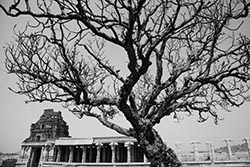 According to Hindu mythology the River Ganga (Ganges) was brought from heaven to earth to quench the drought. But the river was so forceful that it could split the earth into two pieces if allowed to fall on earth. Lord Shiva consented to take the impact by allowing the torrent of Ganga to fall on his matted hair. Thus helping to release a smooth flowing river on to earth from his hair.
According to Hindu mythology the River Ganga (Ganges) was brought from heaven to earth to quench the drought. But the river was so forceful that it could split the earth into two pieces if allowed to fall on earth. Lord Shiva consented to take the impact by allowing the torrent of Ganga to fall on his matted hair. Thus helping to release a smooth flowing river on to earth from his hair.
Driving towards the Vitthala temple, on the main road one can see the remains of the water ducts and fountain parts. Just across the road is the Bhojanasala, the community dining area with rows of food plates carved on the rock slabs. 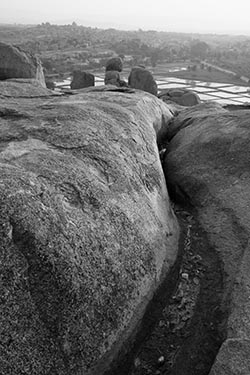 Cars need to be parked about 2 kms away from the Vitthala Temple complex. Electric cars take the visitors thereafter. The cost is just Rs 20 per person. I chose to walk the distance since enroute I could get the opportunity to see many of the old ruins including the stables, pushkarni and the bazaar. I opted for the electric car for my return trip.
Cars need to be parked about 2 kms away from the Vitthala Temple complex. Electric cars take the visitors thereafter. The cost is just Rs 20 per person. I chose to walk the distance since enroute I could get the opportunity to see many of the old ruins including the stables, pushkarni and the bazaar. I opted for the electric car for my return trip.
As the epicenter of Hampi’s attractions, Vitthala Temple is the most extravagant architectural showpiece of Hampi. The temple is built in the form of a sprawling campus with compound wall and gateway towers. There are many halls, pavilions and temples located inside this campus. Vitthala, after whom the temple is known, is a form of Lord Vishnu. This aspect of Vishnu was worshiped in this part of the country as their cult deity by the cattle herds. The temple was originally built in the 15th century AD. Many successive kings have enhanced the temple campus during their regimes to the present form. You can even see the remains of a township called Vitthalapura that existed around this temple complex. The highlight of Vitthala temple is its impressive pillared halls and the stone chariot. The halls are carved with an overwhelming array of sculptures on the giant granite pillars. The stone chariot located inside the campus is almost an iconic structure of Hampi. 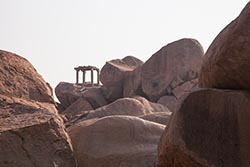 It may appear as a monolithic structure. In reality this stone shrine was built with many giant granite blocks. The joints are smartly hidden in the carvings and other decorative features that adorn the Stone Chariot. The chariot is built on a rectangular platform of a feet or so high. All around this platform is carved with mythical battle scenes. Though the chariot is not resting on it, the four giant wheels attached mimic the real life ones complete with the axis shafts & the brakes. A series of concentric floral motifs decorate the wheels. It appears from the marks on the platform, where the wheels rest, the wheels were free to move around the axis.
It may appear as a monolithic structure. In reality this stone shrine was built with many giant granite blocks. The joints are smartly hidden in the carvings and other decorative features that adorn the Stone Chariot. The chariot is built on a rectangular platform of a feet or so high. All around this platform is carved with mythical battle scenes. Though the chariot is not resting on it, the four giant wheels attached mimic the real life ones complete with the axis shafts & the brakes. A series of concentric floral motifs decorate the wheels. It appears from the marks on the platform, where the wheels rest, the wheels were free to move around the axis.
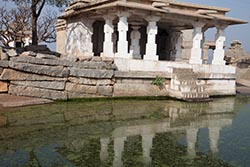 Facing the Stone Chariot, a series of steps flanged by elephant balustrades gives access to this elevated open hall called the Maha-Mantapa (the great hall). The balustrades on the east and west porch of this hall is more dramatic with giant lion Yalis fighting the relatively dwarf elephants. The Maha-Mantapa stands on a highly ornate platform. This fluted platform is carved with a series of floral motifs. The lowermost of it is a chain of horses, its trainers and the traders.
Facing the Stone Chariot, a series of steps flanged by elephant balustrades gives access to this elevated open hall called the Maha-Mantapa (the great hall). The balustrades on the east and west porch of this hall is more dramatic with giant lion Yalis fighting the relatively dwarf elephants. The Maha-Mantapa stands on a highly ornate platform. This fluted platform is carved with a series of floral motifs. The lowermost of it is a chain of horses, its trainers and the traders.
The main highlight of the Maha-Mantapa is its richly carved giant monolithic pillars. The outermost of the pillars are popularly called the musical pillars. These slender and short pilasters carved out of the giant pillars emit musical tones when tapped. Probably these do not belong to any of the standard musical notes, but the musical tone of the vibes earned it’s the name. Unmindful curiosity of the visitors has damaged many of these pilasters and tapping on it is banned for the sake of preservation. 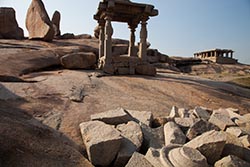 The eastern hall which is called the musicians hall is notable for sculptures of musicians on the pillars. Each of the pillars surrounding this hall is sculptured with musicians, drummers and dancers.
The eastern hall which is called the musicians hall is notable for sculptures of musicians on the pillars. Each of the pillars surrounding this hall is sculptured with musicians, drummers and dancers.
The southern hall is dominated with the rampant mythical creatures called Yalis. The capitals of each of the pillars branches into heavily ornate corbels with terminating with lotus buds. The northern hall is surrounded with a series of pillars with the Narasimha (the man-lion incarnation of Vishnu) themes. The most notable ones are that of Narasimha slaying Hiranyakashipu on his lap. Prahlada is seen sitting at the base in a praying posture. 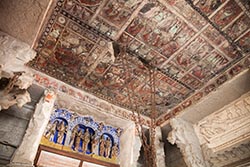 The inner sanctum is devoid of any idol. A narrow and unlit passageway encircles the inner sanctum. A few steps on either sides of the sanctum’s main door give access to this passage. The outer wall of the sanctum is richly decorated with the Kumbha-Pankajas - the motifs where lotus flower flows out of a pot.
The inner sanctum is devoid of any idol. A narrow and unlit passageway encircles the inner sanctum. A few steps on either sides of the sanctum’s main door give access to this passage. The outer wall of the sanctum is richly decorated with the Kumbha-Pankajas - the motifs where lotus flower flows out of a pot.
Next, we walked towards the banks of the Tungbhadra River. Enroute is this 5-meter tall ‘balance’. Also called as Tula Bhara or Tula Purushadana, the king used to weigh himself with gold, gems, silver and precious stones to be distributed to the priests. It’s believed that this had been done during the special ceremony seasons like solar or lunar eclipses. There are three loops on top of the balance, into which the balance is actually hung. Also in one of the pillars is the king’s image carved along with his concerts. 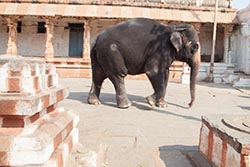 Hampi is located on the south bank somewhere in the middle of this river’s path. In this area the river takes a number of twists are turns owing to the rocky terrain. The river has immense significance in forming the political & religious history of Hampi. The river along with the boulder-strewn hills formed the northern barrier of the capital. It was not easy for an invading army cross the river without the fate of a sure defeat.
Hampi is located on the south bank somewhere in the middle of this river’s path. In this area the river takes a number of twists are turns owing to the rocky terrain. The river has immense significance in forming the political & religious history of Hampi. The river along with the boulder-strewn hills formed the northern barrier of the capital. It was not easy for an invading army cross the river without the fate of a sure defeat.
The river is in fact formed by the union of two rivers Tunga and Bhadra and hence the name. Both Tunga & Bhadra Rivers originated on the eastern slopes of the Western Ghats. Tungabhadra flows in a more or less northwest direction before joining the eastern river Krishna. The Krishna River finally ends into the Bay of Bengal. 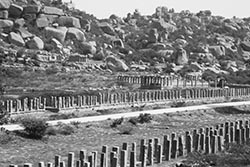 The Vijayanagara kings took advantage of the river by constructing a host of irrigation canals and aqueducts. A highly networked water supply system fed the manmade water bodies in the urban core of the palace area. Many of the ancient canals are still in use to irrigate the surrounding agriculture fields.
The Vijayanagara kings took advantage of the river by constructing a host of irrigation canals and aqueducts. A highly networked water supply system fed the manmade water bodies in the urban core of the palace area. Many of the ancient canals are still in use to irrigate the surrounding agriculture fields.
It was 2PM and we really needed some food to be able to continue further on. A few kms. from Vitthala Temple is a small restaurant named Tamarind. Under the shade of the trees, we had a wholesome meal. Surprisingly, the restaurant offered varied cuisine. Do give it a try. 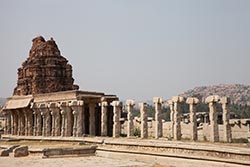 We next reached the queen’s bath.
We next reached the queen’s bath.
For some mysterious reasons this was called as the queen’s bath. But in all probability this was a royal pleasure complex for the king and his wives. The whole building is made with a veranda around facing a big open pond at the middle. Projecting into the pond are many balconies. An aqueduct terminates in the pond. The balconies are decorated with tiny windows and supported by lotus bud tipped brackets. The whole pool is open to the sky. This brick lined pool is now empty. But it’s believed once fragrant flowers and perfumed water filled this bathing pool. At one end of the veranda you can see a flight of steps giving access to the pool. The domical roof of veranda is a spectacle in itself. The bath is surrounded by a water body, probably designed to prevent intruders from walking into the place. 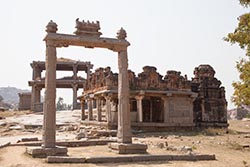 Our next stop was the Royal Enclosure.
Our next stop was the Royal Enclosure.
This fortified area had been the seat of power of the fallen empire. Sprawling over many hundreds square meters, this fortified area is scattered with a number of interesting relics. The most imposing structure in this area is the Mahanavami Dibba or the Dassera Platform or the ‘House of Victory’. Other structures include the King's Audience Hall or the 100 Pillared Hall; Stepped Tank; Bathing Area; a huge swimming pool style tank and the underground chamber that safeguarded the royal treasure. The Royal enclosure area is dotted with numerous other relics, crisscrossing aqueducts supplying water to these water bodies. 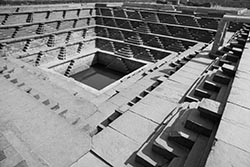 Adjacent to the Royal Enclosure is the Zenana Enclosure.
Adjacent to the Royal Enclosure is the Zenana Enclosure.
Zenana enclosure was a secluded area reserved for the royal women. This walled harem houses many interesting highlights. The major attraction is the Lotus Mahal - a pastel coloured two-storied arched pavilion. The whole area was the private enclosure for the royal women folks. Three watchtowers can be seen at the corners of the enclosed area. You can spot these two storied towers close to the southeast, northeast and northwest corners. These again were built in the hybrid Indo-Islamic architecture style. Being the ladies quarters, it has been said that eunuch soldiers guarded the area. 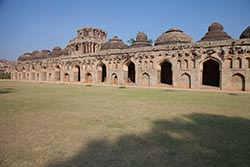 The whole Zenana enclosure is encircled with tall and broad walls made out of cut stones arranged in interesting patterns. The construction style of the wall is noteworthy. The enclosure had been strategically designed for the women folks to watch the royal ceremonial functions or the march past in privacy.
The whole Zenana enclosure is encircled with tall and broad walls made out of cut stones arranged in interesting patterns. The construction style of the wall is noteworthy. The enclosure had been strategically designed for the women folks to watch the royal ceremonial functions or the march past in privacy.
However there is another school of archeologists who believe this was never used as the women’s area. The archeologists assigned the names arbitrarily than based on some assumptions. The closeness of the nearby structures (the elephant stables, the guards quarters, etc.) suggests this was not a harem. They believe the Lotus Mahal as a council room for the chief commanders rather than the women’s pavilion; the rectangular enclosed building at the northwest corner as the armory or mint or treasury rather than the quarters for the eunuch guards; and the palace belonged to the king.  The path to the other locations like the Elephant Stable, Guard’s Quarters and a few other temples’ runs through the center of this area. The whole area is now made into a sort of open garden with sprawling lawns. Make it a point to visit the Elephant Stables at the east, the Ranga Temple & Yellamma Temple at the south, the Jain Temples or the Hazara Rama Temple at the southwest.
The path to the other locations like the Elephant Stable, Guard’s Quarters and a few other temples’ runs through the center of this area. The whole area is now made into a sort of open garden with sprawling lawns. Make it a point to visit the Elephant Stables at the east, the Ranga Temple & Yellamma Temple at the south, the Jain Temples or the Hazara Rama Temple at the southwest.
The Hazara Rama Temple was a private temple of the king. The temple is special with its exceptionally carved outer walls, an unusual feature in other Vijayanagara temples. The story of Ramayana (the Hindu epic) is impressively carved all around the shrine walls like a comic strip on stone. The inner shrine contains four polished pillars with detailed carvings of godly themes. 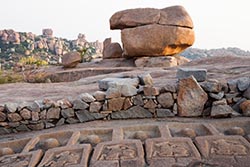 Next on our route was a visit to the Krishna Temple & Bazaar. The temple is dedicated to lord Krishna, one of the ten incarnations of lord Vishnu. In Hindu mythology Krishna is known for his romantic encounters and political shrewdness! This temple was actually dedicated to the lord in his infant (crawling) form. The complex consists of the main shrine, shrines of the goddesses, the chariot / market street and the temple tank (pushkarni). It's said that diamonds and pearls were sold in the marketplace in kgs. At the time of my visit extensive restoration work was in progress.
Next on our route was a visit to the Krishna Temple & Bazaar. The temple is dedicated to lord Krishna, one of the ten incarnations of lord Vishnu. In Hindu mythology Krishna is known for his romantic encounters and political shrewdness! This temple was actually dedicated to the lord in his infant (crawling) form. The complex consists of the main shrine, shrines of the goddesses, the chariot / market street and the temple tank (pushkarni). It's said that diamonds and pearls were sold in the marketplace in kgs. At the time of my visit extensive restoration work was in progress.
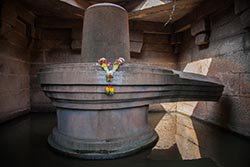 The evening was approaching. To enjoy the sunset we drove Malyavanta Raghunatha Temple located on hill at the outskirts of Hampi. Apart from viewing an awesome sunset and the panoramic view of the city below, the hilltop was home to interesting rock formations and sculptures, especially the series of Shiv Lingas.
The evening was approaching. To enjoy the sunset we drove Malyavanta Raghunatha Temple located on hill at the outskirts of Hampi. Apart from viewing an awesome sunset and the panoramic view of the city below, the hilltop was home to interesting rock formations and sculptures, especially the series of Shiv Lingas.
Well, that was it. By the time we reached our hotel it was late in the evening. Rest was all that we needed. Tomorrow we would return home, but not before taking a brief halt at Kudalasangama. Hampi Image Gallery  Photo viewer Photo viewer
|
|
|
Home |
Charity |
Feedback
Privacy Policy | Terms of Usage © YoGoYo.com. All rights reserved. |













































































